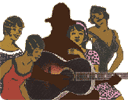I just stumbled across a website here http://home.att.net/~joeshepherd/main.html which contains scans of a magazine called Jazz Information that was published from mid 1939 through late 1941. It was apparently put out by a bunch of recent college grads who were interested in "hot jazz". For most of its life, Jazz Information was a four page weekly.
What might interest the more historically-minded Weenies are the record reviews that Jazz Illustrated published. Real jazz artists got a short paragraph or two, but each issue reviewed a few (the average seems to be about three) records by what we'd call blues artists today. These blues artists tended to be from the Chicago mainstream - Big Bill Broonzy, Georgia White, Jimmie Gordon, Walter Davis, Ollie Shepard, Sonny Boy Williamson and the like - and they generally get one or two sentence reviews. Here's a typical one:
I think these reviews are interesting for several reasons. It's interesting to see what contemporary listeners thought of the music. And the late 1930s/early 1940s Chicago sound was so maligned by various writers in the 1960s and 1970s that it's interesting to see a bunch of young hipsters, into the hottest music of the day, devoting some of their attention to these artists.
What might interest the more historically-minded Weenies are the record reviews that Jazz Illustrated published. Real jazz artists got a short paragraph or two, but each issue reviewed a few (the average seems to be about three) records by what we'd call blues artists today. These blues artists tended to be from the Chicago mainstream - Big Bill Broonzy, Georgia White, Jimmie Gordon, Walter Davis, Ollie Shepard, Sonny Boy Williamson and the like - and they generally get one or two sentence reviews. Here's a typical one:
Quote
SONNY BOY WILLIAMSON (BB 8333)
Good Gravy -- T. B. Blues.
This blues singer, accompanying himself on harmonica and with guitar and piano, sings the T. B. Blues - "Oh, T. B. killin' me; I want my body buried way down in Jackson, Tennessee" -- as if he meant it. He seems to get as much pleasure out of the coupling, which is a bit of jive done to the tune of "Mama Don't Allow"; but we can't follow him.
I think these reviews are interesting for several reasons. It's interesting to see what contemporary listeners thought of the music. And the late 1930s/early 1940s Chicago sound was so maligned by various writers in the 1960s and 1970s that it's interesting to see a bunch of young hipsters, into the hottest music of the day, devoting some of their attention to these artists.









 Logged
Logged

